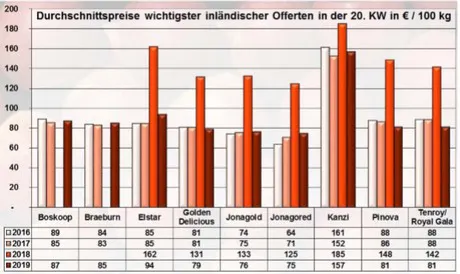Regarding apples, a change of supply is slowly starting: the presence of European batches has diminished and that of overseas imports has been growing. The campaign of the dominant native, Italian and French batches turned into the home straight and the importance of the complementary Dutch, Belgian and Polish articles was limited as well.

When the quality of the goods was right, customers were always ready to buy them. The rising prices were the result of reduced availability. In Frankfurt, the goods from Italy and France occasionally suffered from quality problems. That menat that supplies from the southern hemisphere met with a solid demand over there. In the overseas segment, New Zealand with Royal Gala and Braeburn was generally dominant. The first Pink Ladies from Argentina and Chile as well as Jazz apples from New Zealand and Chile extended the product range.
Pears
The markets were sufficiently supplied with the -now dominant- South African and Chilean shipmens. The sales were quite subdued and there weren't any special highlights to speak of.
Table grapes
Meanwhile, Chile had displaced South Africa from first place and dominated the markets with its Thompson Seedless and Crimson Seedless. In general, the quality of the articles was most convincing.
Strawberries
The domestic deliveries picked up noticeably, but the products fell somewhat short with regard to color and size. That meant that sales slowed down, and they were already somewhat slow due to the low temperatures and the bad weather.
Lemons
There were subtle shifts here, as more and more Spanish Vernas arrived, increasingly replacing the established Primofiori. In addition to this, the first South African imports appeared on the scene.
Bananas
The trade was generally relatively quiet. However, the inflow from the ripeners correlated to a sufficient extent with the level of demand. This usually meant that prices remained constant .
Cauliflower
Although a large number of suppliers, from different regions were involved in the events, demand could not be met consistently. As the supply was initially scarce, prices went upwards quite noticeably.
Lettuce
Iceberg lettuce came in primarily from Spain, but supplies from that nation dropped sharply. In line with this, the presence of domestic batches expanded, indicating a rapid change at the top of the range.
Cucumbers
The availability of the dominant domestic and Belgian articles grew considerably. The rather feeble demand could be satisfied without any problems. Most of the prices dropped off, as the sales options were too small.
Tomatoes
Although the demand was quite good overall, it did not keep pace with the abundant supply. That meant that stocks formed, and these had to be cleared as quickly as possible. To do that, marketers all over resorted to lowering their prices.
Sweet peppers
The Netherlands were dominant here, with Turkey and Belgium completing the market. Prices were down in overall. The reasons for this were mainly oversupply, which meant that supply simply outstripped the demand.
Asparagus
The markets were mainly served by local goods. Other European countries, such as the Netherlands, Poland and Greece, supplemented the scene with small shipments.
